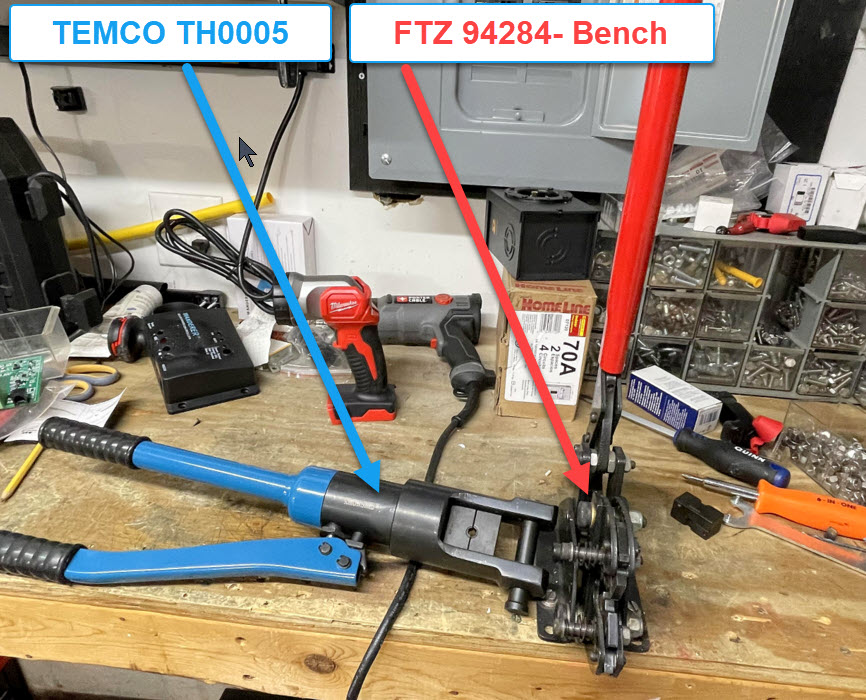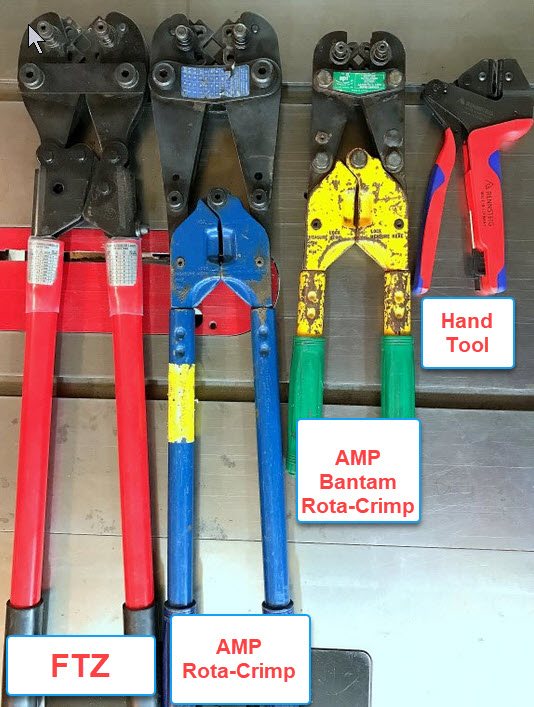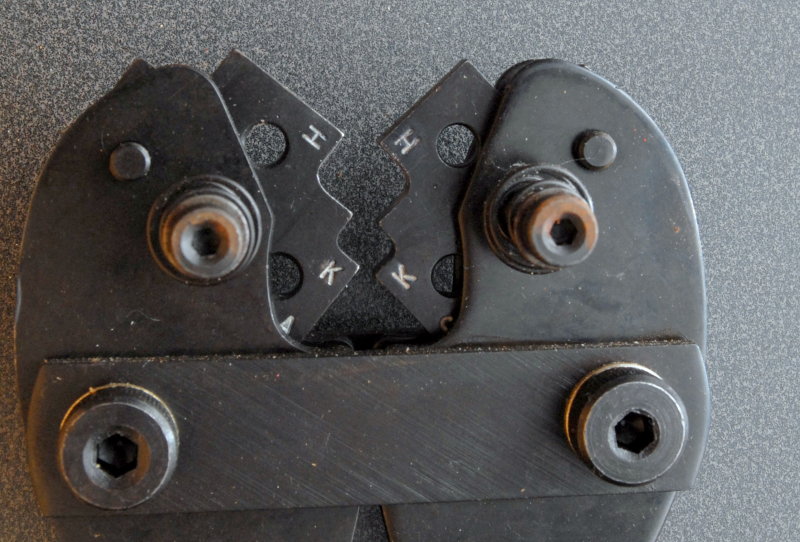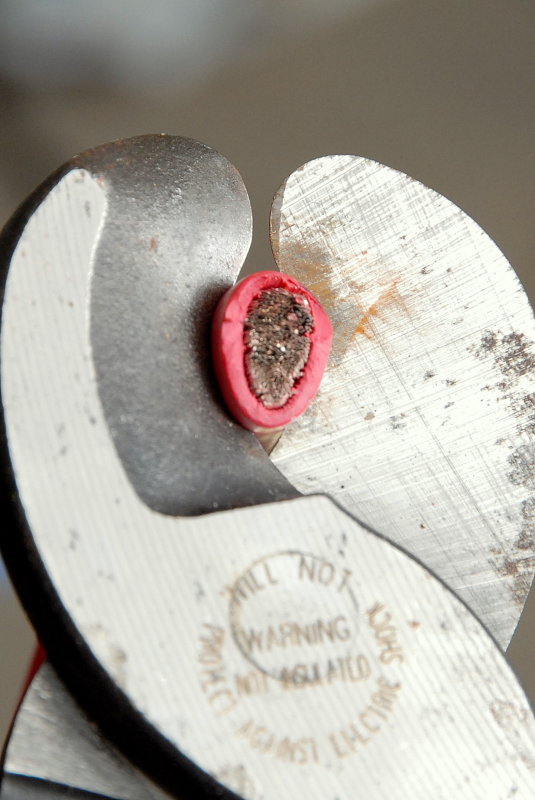Pick Your Crimp Tool
FTZ 94284 & Ancor Hammer Crimper
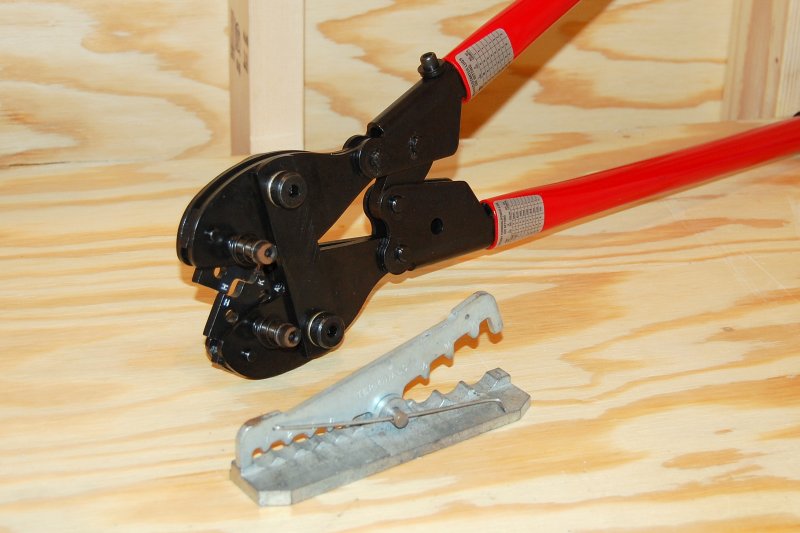
TEMCO TH0005 & FTZ Bench Mount

BUY FTZ 94284 CRIMP TOOL – BAY MARINE SUPPLY
BUY FTZ HEAVY DUTY MARINE LUGS – BAY MARINE SUPPLY
WHAT ABOUT HYDRAULIC CRIMP TOOLS?
As paid Pro’s we have tested at no less 25 different hydraulic tools. We don’t use them in the field. Why?
1- Because they are slow and time is money when you are a paid professional.
2- 98% of these hydraulic tools are using the wrong sized dies even though they lie and stamp “AWG” on the dies.
3- There are just too many dies to lose
Is there a Hydraulic tool you recommend?
The only hydraulic tool we have tested that works well and has correctly sized dies are the TEMCO’s.
BUY TEMCO & FTZ Lug Crimpers- AMAZON
We own both the Ancor hammer crimper and the FTZ 94284, as well as many others. The FTZ 94284 makes a beautiful 360 degree crimp that is extremely solid. In testing we’ve conducted here at Compass Marine Inc. an FTZ made crimp exceeds US MIL Specs! A full 360 degree crimp makes a truly cold formed connection between the wire and the lug.
We are only showing the Ancor “hammer-crimp” tool as an example of an emergency use tool kind of like your spare tire. Good to have as a spare that you can carry on-board for emergencies but no where near the quality of the FTZ rotating die crimper. The FTZ is just that much better for not that much more money. The Ancor tool makes a dimple-crimp which can damage conductors, and still not make the best electrical connection. When you’re crimping cables that will start 800HP diesels there is simply no room for a cheap dimple- crimper in the tool box.
I consider the Ancor tool an emergency, get you home, tool. Nice to own if you have extra boat bucks floating around but not a tool I’d ever reach for for my own boat or professional primary wiring.
Marinco claimed/claims this tool makes a UL crimp. However, when I called and asked them to furnish documentation of this, or any other testing, there was a complete lull in any data coming out of them. I made three calls and got nothing out of Marinco.
If someone can get this UL documentation, or any legitimate testing data from Ancor/Marinco on this tool, please forward it to me.
As I always say; tools are free, if you DIY!
When you figure that an Ancor hammer crimper would cost you nearly $80.00 and the cost savings in battery cable from a place like Genuinedealz.com is so huge that the high quality crimper is almost no additional expense. This is man math at its best. Do not run this scenario by your spouse.. (grin)
The FTZ 94284, is the non-ratcheting version of this crimp tool. This is an excellent “value” tool that I have used & tested extensively.
The FTZ & AMP Rota-Crimp Tools
So why is it that I believe the FTZ 94284 lug crimping tool represents one of the best values out there for the DIY or even professional electrician? It’s simple, the FTZ 94284 is about as close as you’ll get to the industry gold standard AMP Rota-Crimp 600850 pictured here with the blue handles.
The FTZ is an amazingly good deal & no one else has made a tool comparable to the AMP Rota-Crimp for anywhere near what the FTZ sells for. Sure in pull testing the AMP tools beat the FTZ slightly but the FTZ beats every single Chinese or competitors crimp tool I’ve tested it against using my 5000 pound rated digital load cell. It exceeds even Mil-Spec crimp testing requirements.
All one needs to do is a quick google search typing in; “AMP Rota-Crimp 600850” and you’ll see why the FTZ 94284 is an incredibly good deal. Yes, the FTZ 94284 is now made in China, it used to be made in the USA, but in order to deliver value FTZ moved production overseas.
If you desire the crimp consistency, pull out strength, repeatability & overall crimp quality the FTZ delivers you’d need the AMP/Tyco tools. Yes the Rota-Crimp tools are made in the USA, yet at a price of $1200.00 to $2000.00+ depending upon the source. Ouch!! Sure I love my Rota-Crimp tools & I paid dearly for them, and I use and abuse the hell out of them, but the FTZ is no slouch at all.
Pictured from bottom to top are our:
FTZ 94284 (6GA to 4/0)
AMP Rota-Crimp 600850 (8GA to 4/0)
Amp Bantam Rota-Crimp 601075 (8GA to 1/0)
Rennsteig Hand Held Crimp Tool – Red, Blue Yellow Insulated Terminals (for size comparison only)
Pick Your Lugs
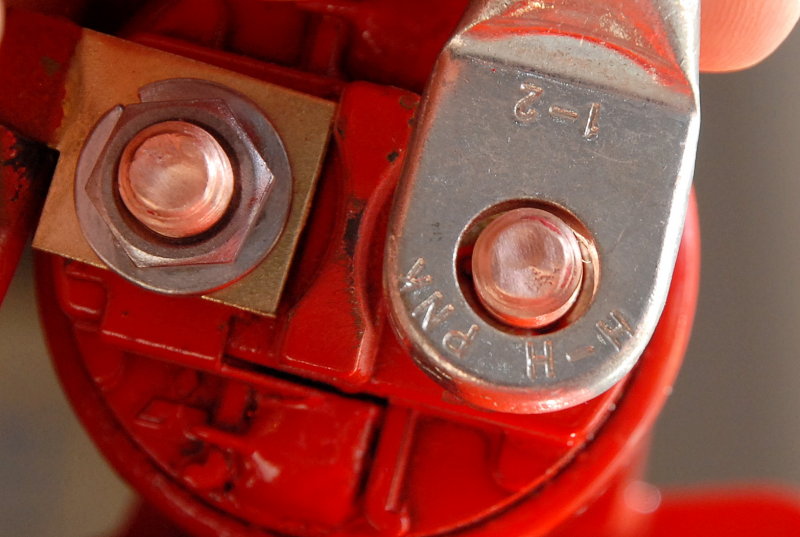
This battery lug is the wrong size for this starter motors terminal post.
A Correct Fit
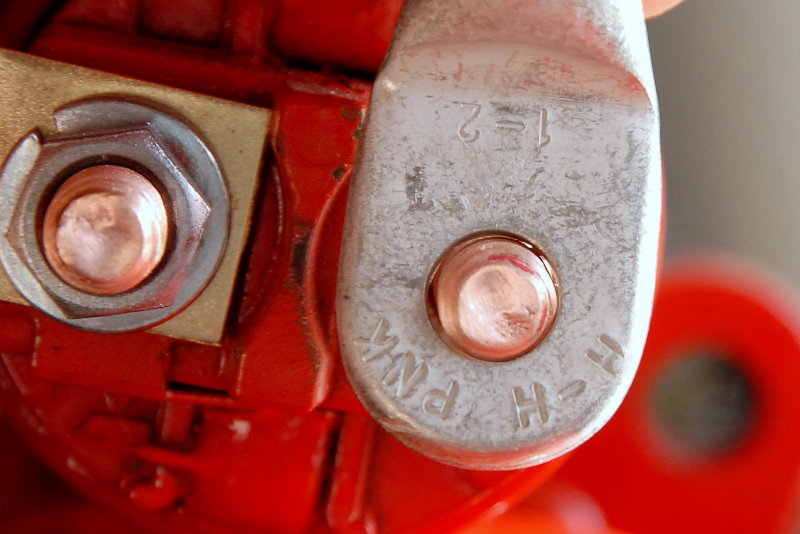
This lug is the correct size for this stud.
Flared Starter Lug vs. Heavy Duty Power Lug
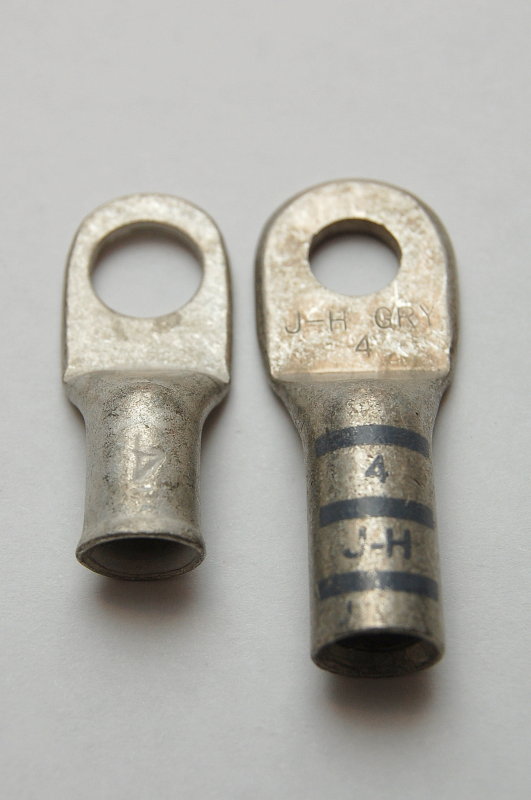
Okay this is where it gets confusing. There are many different lug or terminal standards. The two most common for marine & trucking use are commonly referred to as the Flared Starter Lug, as seen on the left, and the Heavy Duty Power Lug, as seen on the right.
Different manufacturers have slightly different names but FTZ calls them Power Lugs and Quick Cable calls them Magna-Lugs. It is important to note the lug on the left is for 4 GA wire and the lug on the right is also for 4 GA wire.
IMPORTANT: These two lugs use DIFFERENT DIES. When buying a crimp tool please be very careful to choose the correct tool. There are many tools out there marked for 6 GA to 4/0 GA wire that will not work correctly with these terminals and do not come with the proper dies.
When you buy a substandard or incorrect tool you are then left guessing which dies to use for the flared starter lugs and which tool for the heavy duty lugs.
The correct tool will have labels for “Flared Starter Lugs” and for “Heavy Duty Power Lugs“. There are only two relatively affordable tools I know of which meet this lug crimp standard and they are the FTZ and the Quick Cable crimp tools. Most of the other tools out there are made for the industrial lug standard or made by off-shore manufacturers for use with metric wire.
Heavy Duty Power Lugs will always be marked with a color code and have two letters embossed or stamped into the lug. If your heavy duty lugs do not have these colors and letters they are very likely not the proper size for the dies.
Many People have asked me where they can get FTZ lugs from. The answer is: Bay Marine Supply – FTZ Products (LINK)
Flared Starter Lug vs. Power Lug
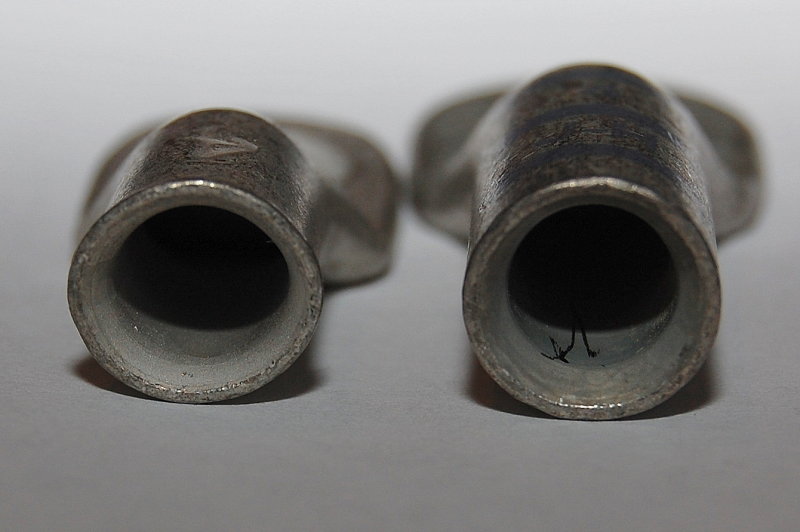
Flared Starter Lugs and Power Lugs are very different. The heavy duty lug on the right is significantly more robust and has a significantly thicker copper wall. There is no flare at the end of a heavy duty lug because they actually machine-bevel the edge. Due to the power lugs thickness it does not need an external flare like the less expensive & less robust flared starter lugs do.
Even without measuring these lugs one can visibly see that there is no way to apply a “one size fits all” die to both of them. Tools that do not list the proper die selection for both flared starter lugs and heavy duty power lugs should be avoided.
Power Lug Die Settings

Let’s look at the settings for the 1/0 Heavy Duty Power Lug that you’ll see crimped later in this article. The chart shows that you pick the lug with BLACK markings and adjust the dies to “E” and “A“.
NOTE:
With a 2 GA wire and a heavy duty power lug the “H” & “H” dies and pink color code are selected.
Flared Starter Lug Die Settings
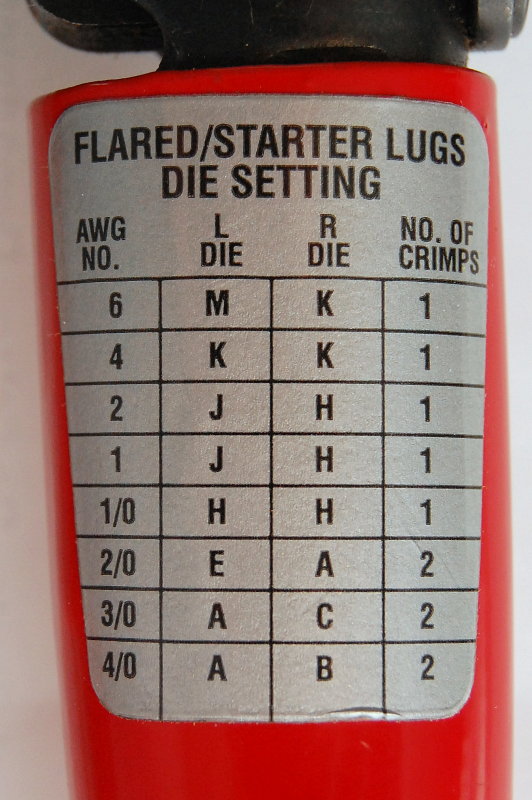
These are the die settings for “Starter Lugs“. In the last image, for Power Lugs, a 2 GA wire took “H” & “H“/pink. You’ll see here that a 1/0 wire using a Flared Starter Lug takes “H” & “H“. This is due to the smaller OD of the Flared Starter Lug as a result of the thinner walled copper used to make the lug..
That is a two whole die size difference due to the quality and raw thickness of the lug. Same wire 1/0 vs. 1/0 but two whole die settings apart. Be very careful to not to confuse flared starter lugs with true heavy duty lugs.
Once again, true heavy duty power lugs will be both color coded and die stamped. Starter lugs are flared at the end and simply marked with the wire gauge.
I personally try and use the heavy duty power lugs when I can but there are some applications where their larger and thicker form factor is a poor fit. There are good applications for both flared and heavy duty lugs. In a high vibration environment, such as an engine, the heavy duty lug is usually the better choice.
Lug & Die Marking / Settings
Industry standardized battery lug crimpers such as the Amp Rota-Crimp, Quick Cable Tools and the FTZ have the die settings and the number of crimps required stamped on the crimp tool themselves. When you use quality marked Heavy Duty lugs like those by FTZ, Quick Cable etc. they will have all the information clearly marked on them as well.
Cheap Lug vs. Quality Lug
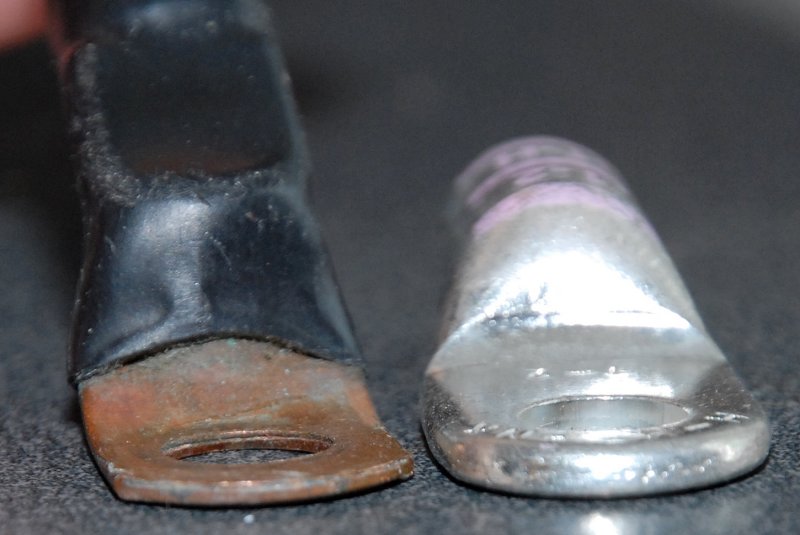
Not all battery lugs are created equal. The lug on the left was purchased at an auto parts store and is cheap, thin & made of un-tinned copper.
The lug on the right is made by FTZ Industries, generally a higher quality product, and is thick tin plated copper. This FTZ lug is a solid connector with no voids or openings.
Anatomy of a Poor Termination
In just this one photo we have;
- Lack of adhesive lined heat shrink
- Bare copper wire
- A battery cable that does not meet the UL Marine spec for stranding
- Oxidation already beginning, too much exposed copper from the wire stripping and a
- A poorly executed hammer type crimp
- Over-crimping
While this fitting did and does work the question would be for how long, and when, not if, it would have let you down? This cable was only two seasons old, located in a very dry area of the vessel and yet was already beginning to oxidize.
Crimp Dies
This is the head of the FTZ lug crimper. It compresses the lug in a circumferential manner (360 degrees) making the entire lug smaller and thus creating a true cold formed connection between wire and lug.
Proper crimps create to little to no resistance. A poor crimp can be a point of resistance and heat generation.
The die heads also have letters marking them. Each of these heads rotates and there are dies from 6GA to 4/0 wire.
Check for Strip Depth

To get a rough idea how far back to strip the wire simply lay the wire next to the lug and mark it with a pen or pencil.
A Clean Cut
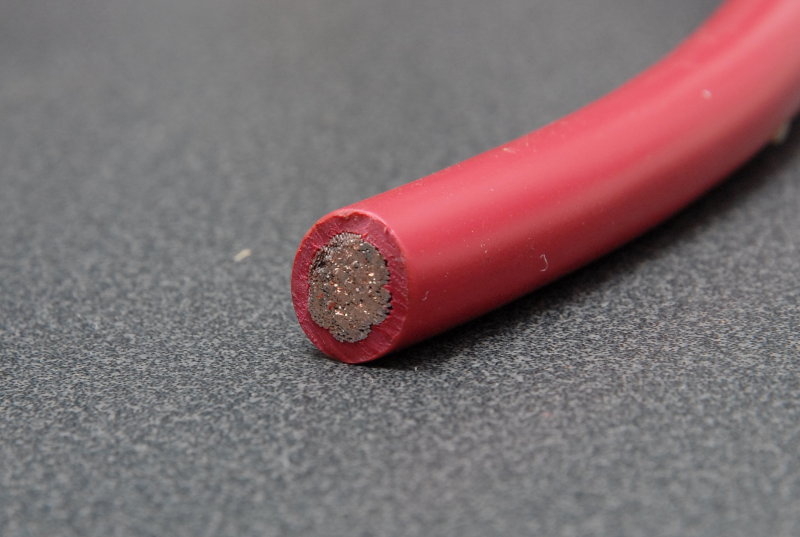
Good quality tools make nice clean cuts.
This Tool Also Works
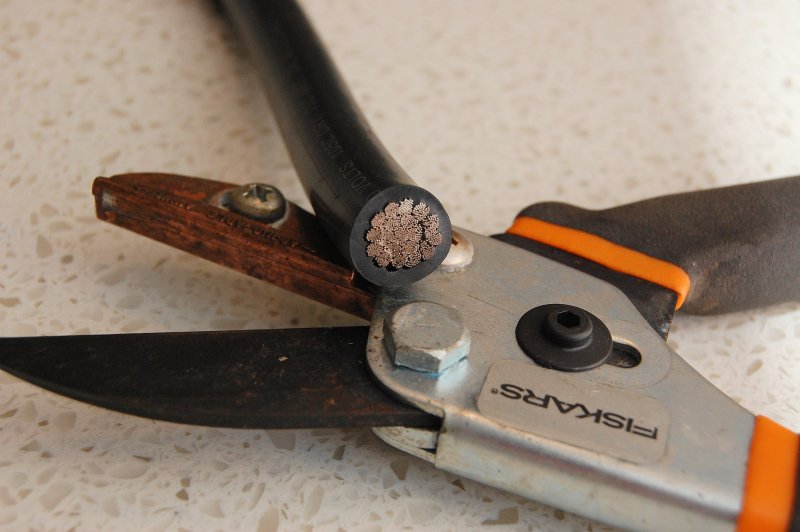
Don’t tell my wife I stole her Fiskars Anvil shears from the garden shed. Laugh all you want but these anvil shears work amazingly well for both stripping the wire, if you’re careful, and for cutting it. I have cut up to 4/0 but it is more comfortable cutting 3/0 and smaller. They costs about $12.00 at Home Depot.
These Fiskars Anvil Pruners are very often my go-to tool for cutting and stripping large GA battery cable. I go through about two pairs per year but overall they cost less than large wire cutters that also go dull and need replacement. The prime reason I like them is because they also fit neatly into my tool bag. I’ve found them on-line for as little as $9.00….
Strip The Wire
To strip the battery cable simply close the wire cutters around the jacket and make a circle. Do not press to hard or you will damage wire strands. If you look closely you can see that none of them have been cut. There are many ways to strip battery cable I just find this one, with a little practice, to be the quickest and easiest. I think the Fiskars do a better job and that is what I use most often.
My only suggestion here is to use proper wire cutters similar to the ones pictured or use the Fiskars. In this photo I’ve chosen to use my Klein High-Leverage Cable Cutter’s Part No. 63050. They cost about $20.00 at Home Depot.
Chanel-Lock also makes a set that are slightly less money but nowhere near as accurate and they dull quickly .
Klein Tools are fairly high quality and will hold an edge for a long time when compared to products like Chanel-Lock. The right tool, for the right job, is always well worth the expense, unless of course you discover a real bargain like the Fiskars tool..
Using a set of Diagonal Cut Pliers or Dykes, as they are often called, will not make as clean or as nice a cut, or strip, as well as a set of cable cutters or the Fiskars.
Test Depth = Incorrect Fit

Here I’ve stripped the wire and inserted it until it bottomed out in the lug. I went a little overboard here for illustrative purposes. This insert dept of stripped wire is simply too long.
Test Depth = Correct Fit
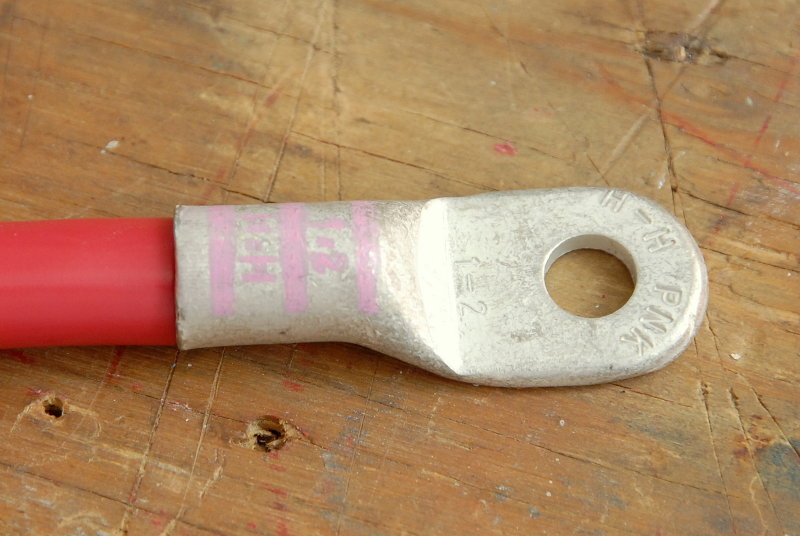
I’ve trimmed some of the wire off, with my Klein cutters, and re-inserted it. The insert depth fit is now ready to be crimped.
Install Shrink Tube
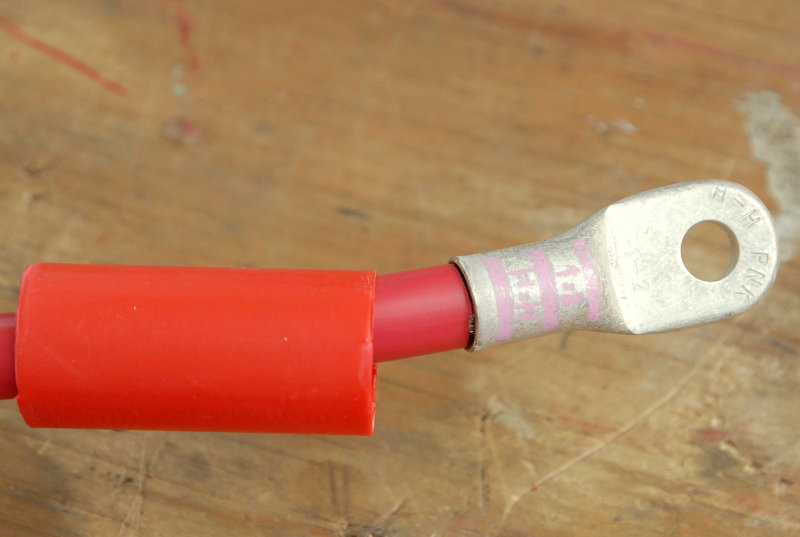
TIP: Depending upon your battery lug and wire size your chosen adhesive lined heat shrink tube may not fit over the lug after it has been crimped. Simply slide the heat shrink tubing over the wire before you make the crimp. I usually cut my heat shrink to about 2.75″ inches long so it’s long enough to be labeled..
Crimp Position

This FTZ Industries battery lug is industry standard black color code for 1/0 wire and is embossed with the letters E-A for the die settings.
This E-A embossing tells you the correct dies to use when crimping with industry standardized crimpers. The industry gold standard crimper for battery lugs is the AMP Rota-Crimp tool. While there is no standard that I can find for lug crimping tolerances the Amp is the tool of choice for many professionals. Unfortunately this tool costs well over $1000.00 and mine is at the bottom of Casco Bay somewhere. D’oh ! For the price I replaced it with the FTZ but it has proven excellent so I’ve yet to purchase another AMP Rota Crimp.
FTZ makes own tool, which is significantly less money than the AMP, yet uses the same rotating die standard with the same letter codes as the AMP tool. I’ve crimped Ancor, FTZ, Quick Cable and AMP lugs with the FTZ crimper and it works equally well on all those lugs.
In the photo there are two positions separated by black stripes where your crimp tool is to make two separate crimps. In this picture I am in the position to make the first crimp.
Make The Crimp
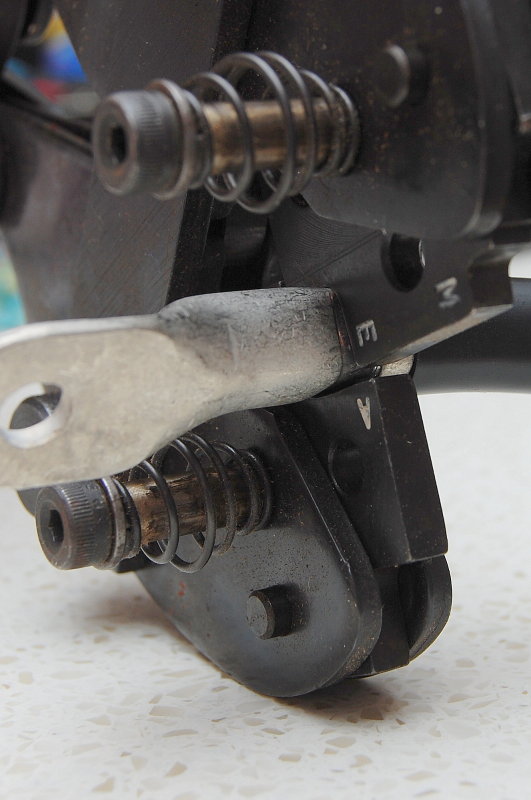
Technically, with battery lugs, the first crimp should be made at the end of the lug closest to the wire. The second crimp is then made closest to the hole. I have done it backwards and never had a problem. This is backwards from the way industrial compression lugs are crimped. With industrial lugs you start at the stud hole end and work towards the wire. I have even seen some battery lugs marked backwards and others marked forwards. I guess if the industry can’t agree why should we really care.
The reason it’s suggested to crimp the wire end first, with battery lugs, is to keep the wire jacket distance from growing away from the lug. You’re applying adhesive heat shrink so a little gap is no big deal.
With the diamond crimp tool you can develop sharp edges on the non-rounded part of the die. In order to alleviate this I consulted with both FTZ and Quick Cable and decided to do two crimps in each spot.
Make the first with the lug parallel to the crimp head then, as seen here, flip it 90 degrees or vertical and make one more crimp in the exact same spot. Doing this rounds over all sides making for a very neat and tidy crimp under the heat shrink. While not entirely necessary it does make for a neater and more professional looking job.
Round Side / Sharp Side

When the lug is crimped once it has two nice rounded corners and two pointy corners. By flipping it 90 degrees and making a second crimp you now have four nicely rounded corners on the lug. Simple & easy..
First Crimp Done

Here is a look at the first crimp after double crimping it, rotating it and rounding all corners.
Finished Crimping

The finished crimp is well executed and well formed. The FTZ crimp tool actually reduces the diameter of the lug similar to swaging standing rigging. The Ancor hammer crimper simply distorts the lug and puts a dimple in it.
It Makes A Beautiful Lug
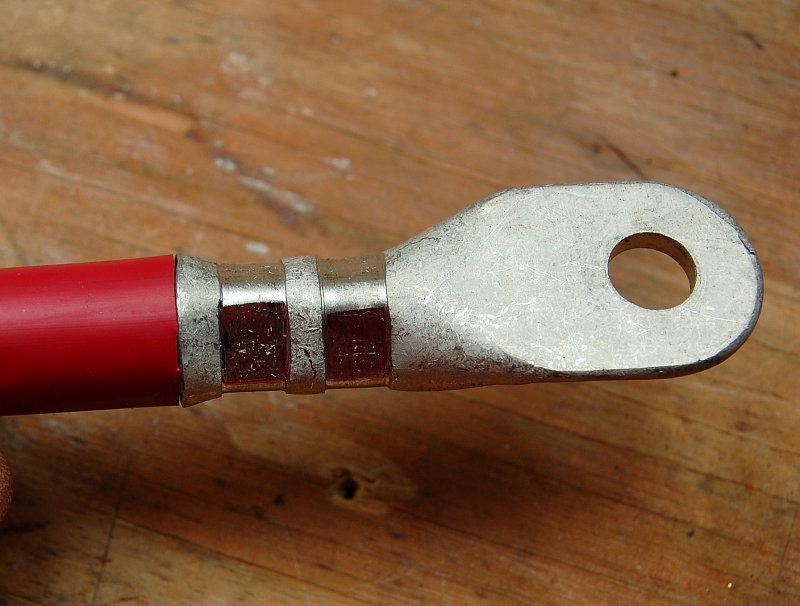
Again here is a positive battery cable & lug made with the rotate method so all corners are nicely rounded. You can see how it physically reduces the OD of the lug.
NOTE: This tool makes such a perfectly crimped lug that when I experimented and tried to also solder one, after crimping, no solder would flow beyond the first crimp band. This crimp tool makes a completely water tight and solder tight joint. In the aerospace industry they refer to this as a “gas tight” crimp.
Slide the Shrink Tubing Into Place

The heat shrink tubing is now in place ready to have the heat applied.
Adhesive Lining
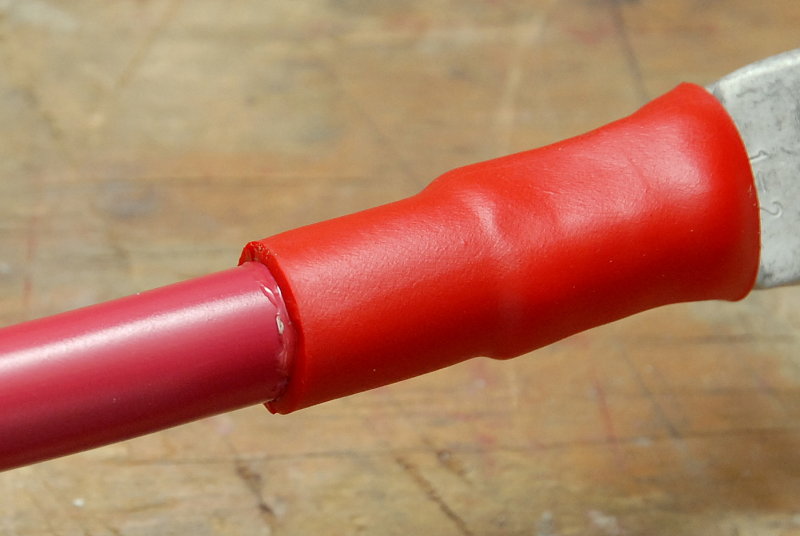
When heat shrinking battery cable it is always best to use an adhesive lined product designed for heavy duty use. This is commonly referred to as Dual Walled Heat Shrink. By doing so you create a hermetically sealed connection that will allow no water or moisture to corrode or damage the crimped fitting.
You also need to ensure that the adhesive melts out of the ends of the shrunk connection. If you do not see the glue leaking out, as you do in this photo, continue with your heat gun until you do. Remember to heat evenly..
The Finished Product

This is what your work will look like when done.
Poor Quality Tool- Harbor Freight Hydraulic Crimp Tool

After many requests I have added my experiences with the Harbor Freight Hydraulic Crimper. I can sum it up in two words, very poor….. Read on if you want the why behind my review…. (wink)
Please let’s not misconstrue my review above. It’s not to say the Chinese can’t do things right, they certainly can, and they do every day, but when you send stuff out to the lowest, bottom feeder bidders, you often get what you pay for, as is the case here.
This tool was $59.99 and worth about what the corrugated box cost to ship it in. Go figure..
Lets get something out in the open, I like Harbor Freight Tools, for certain things. I am not dissing all their products in any way… I recently bought boxes of nitrile gloves for a 1/3 of what I can buy them for at my local hardware store, and they were the same exact brand. I like their wrench sets because I lose lots of wrenches and consider them disposable. HFT is good for many things and they truly serve a purpose. You can’t take that away from them.
This tool however is not own of their better products.
1- The die sizes are apparently from some mythical made up Chinese back room standard. They are not AWG sized dies. I repeat, they are not AWG sized dies, despite being labeled as such. This is not only misleading it is blatant lying. They are so bad, and so mislabeled, I suspect some poor soul in a dirty dark room, with no internet connection, actually made it up after complaints from US customers that the dies were not AWG sized?
2- Apparently, with the earlier models of this tool, they were originally labeled in the MCM standard. I can see the meeting at HFT tools now; “Oh yeah we can fix that lets just re-label the MCM dies in AWG.“. Sorry HFT, it doesn’t work like that…
3- Even when you do find a die that works okay they tend to fall out of the tool and into the bilge. My tool/dies are mildly magnetic but no where near enough to prevent the dies from falling out and getting lost. HFT will not and can not get you replacements. I tried..
4- The dies are horribly machined, even if machined to a mythical made up wire standard…
5- Can someone PLEASE tell the Chinese that there is NO SUCH AWG wire as 7 GA in the real world…….. WTF!
1/0 Lug In The 1/0 Die
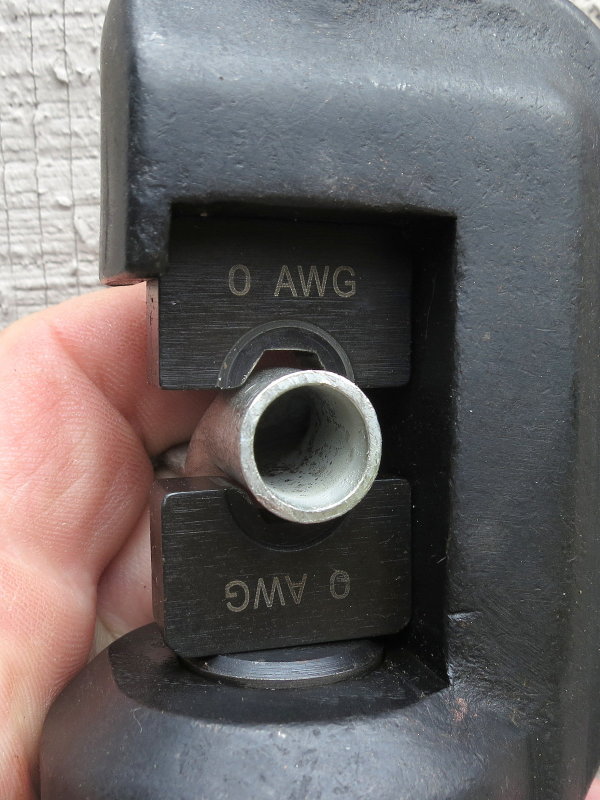
Here we go, this picture is an HFT 1/0 labeled die with a 1/0 lug in it. Yeah, that fits….
The lugs used in this demonstration were all starter lugs or the smallest OD lugs that will fit over 1/0, 2GA or 4GA wire. These were not the heavy duty power lugs.
The heavy duty lugs are considerably larger, OD wise. In fact a 1/0 heavy duty lug will not even fit between the jaws of this crimp tool when wide open.
Crimping The 1/0 Lug In 1/0 Die

Yeah right…..! Bad fit, wrong size, grossly mislabeled die, no good…..
Straining….
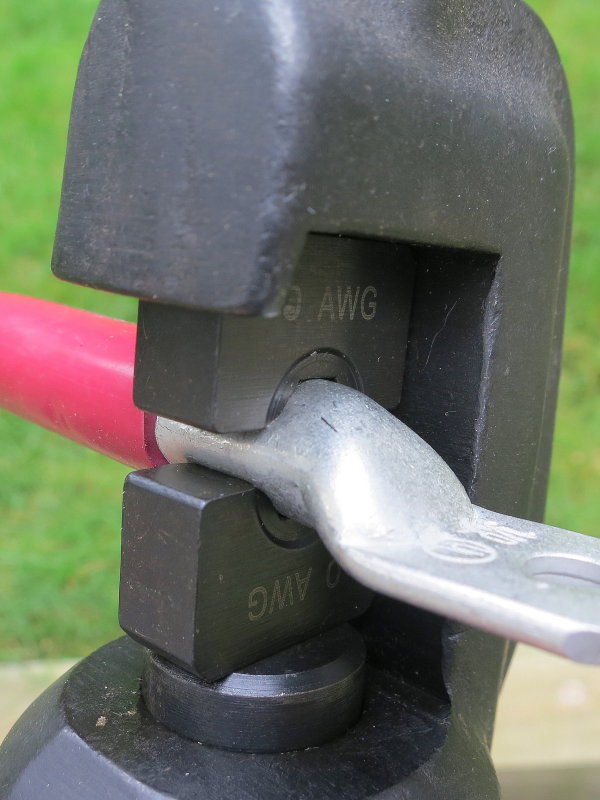
This 1/0 labeled die is so far off this is not even laughable.
Ouch………
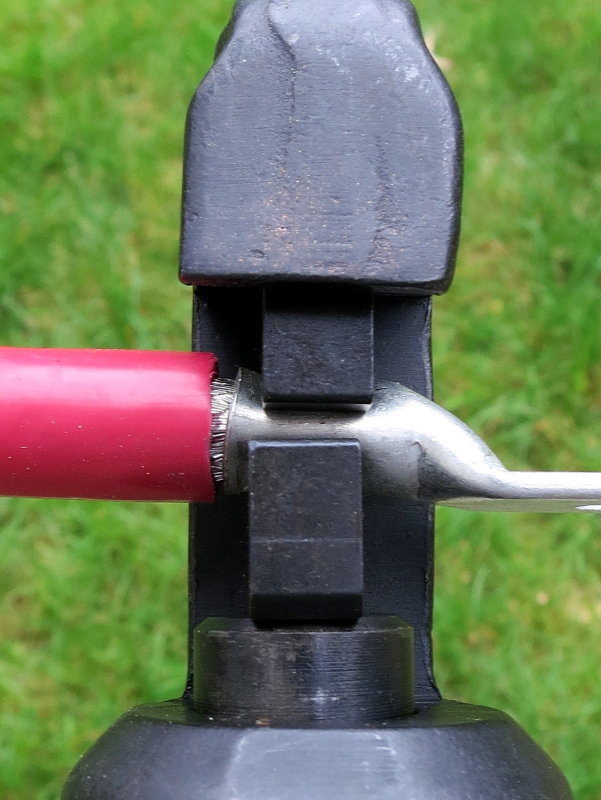
Beautiful alignment for the top and bottom dies. Should I go on…….?
OVER-CRIMP!
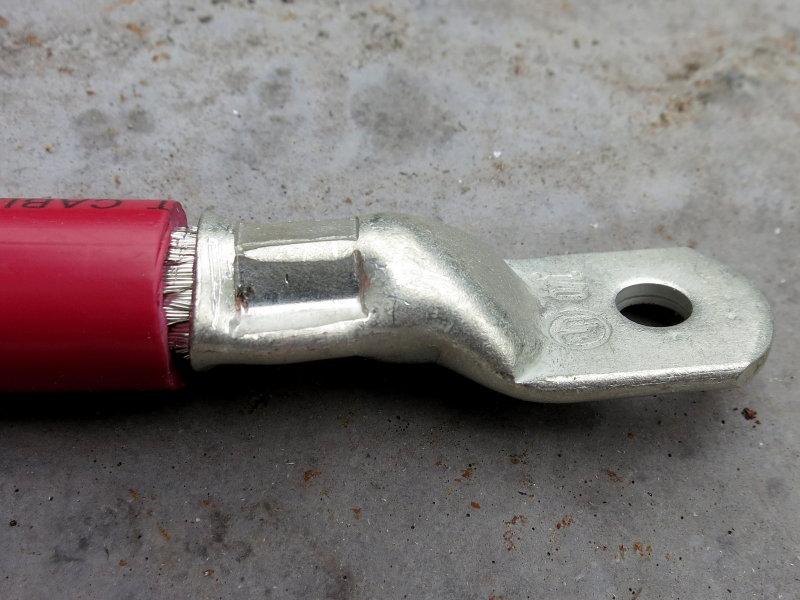
This is not how a crimp should be formed. Over-crimping can fracture wires and drastically weaken the lug. Over-crimping is equally as bad as under-crimping.
So the 1/0 lug cost me $3.30 and the 1/0 wire about $2.00 so I am now up to $65.30 trying to figure out this mythical HFT/Chinese die standard….. Sheesh…
2GA Lug In a 1/0 Die..?

Well 1/0 wire and flared starter lugs did not work in the 1/0 AWG die so lets try skipping right over 1GA and go straight to 2GA…
Here is a 2GA lug & wire which is two full sizes smaller than the 1/0 die is labeled for…..
Think it will work??
Huh?
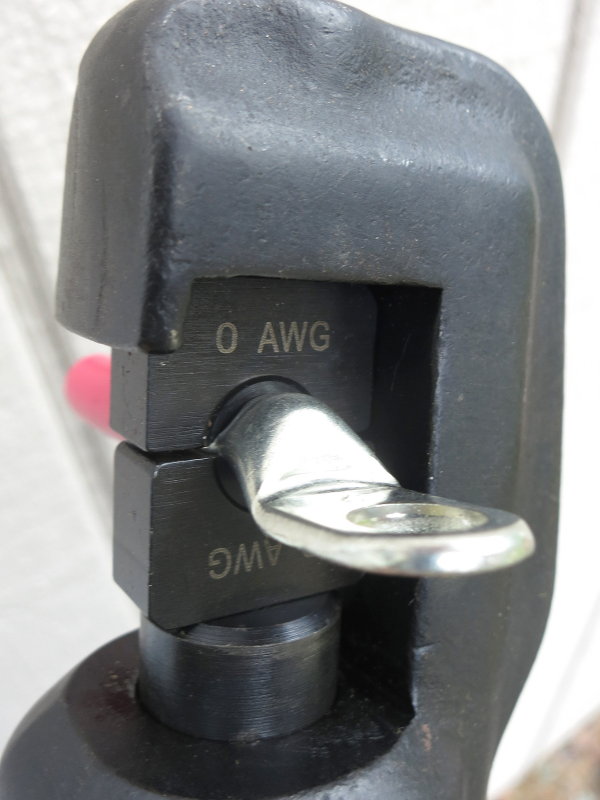
And crimp……..
Holy Over-Crimp Batman!
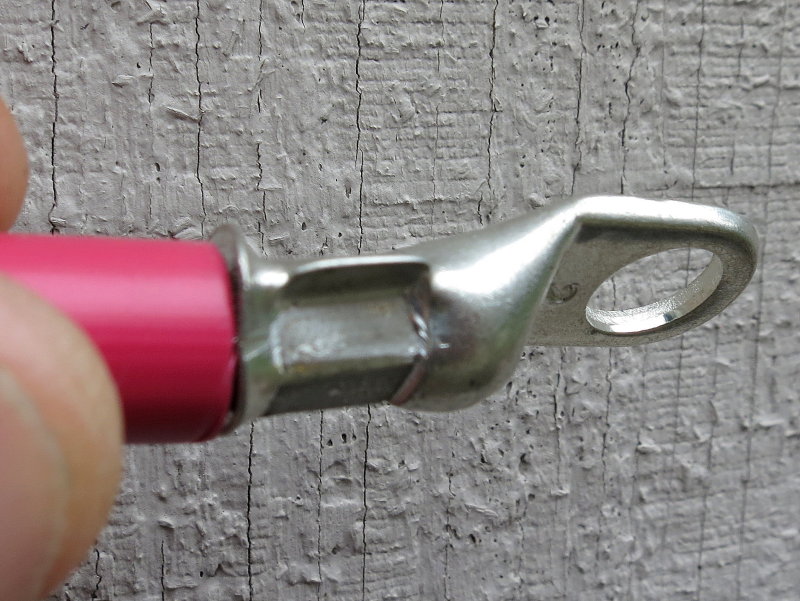
Even a lug and wire two sizes smaller than the HFT crimp die is labeled for, and this tool, and I use that term lightly, is still GROSSLY over-crimping. This is NOT GOOD. A crimp should never look like this, never….
So, another $3.30 lug and $1.85 in wire ruined and we’re closing in on $70.00…………
Perhaps a 4GA Lug In a 1/0 Die?

I am desperate now…. So let’s try THREE SIZES SMALLER……
Harbor Freight 1/0 AWG Die
1/0 = FAIL
1 GA = FAIL
2GA = FAIL
4GA = Let’s see…….
That’s a Bit Better
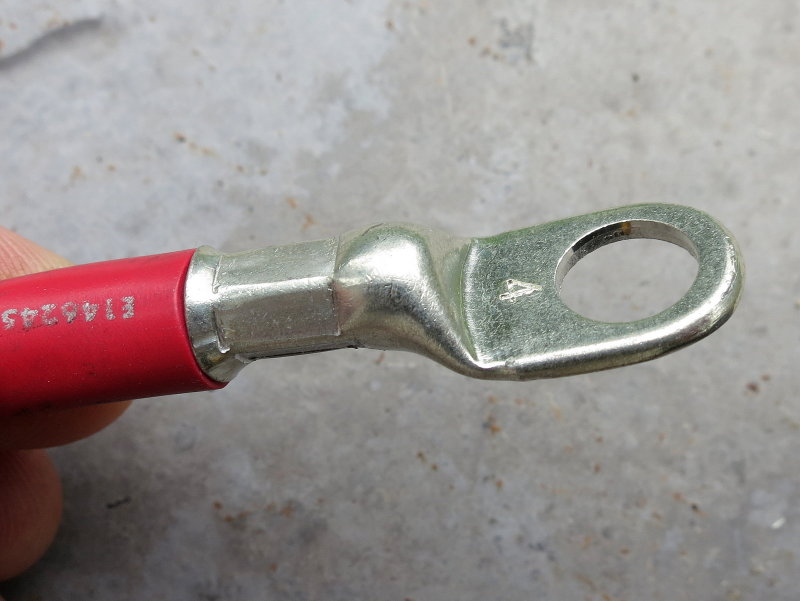
Finally, a crimp that looks somewhat acceptable. Only problem is this tool is sold to crimp UP TO 1/0 wire and it will only crimp to 4GA.
My RIP OFF ALERT is beeping loudly..
Harbor Freight Hydraulic Crimp Tool = CAVEAT EMPTOR
You will ruin a lot of battery lugs trying to figure out this mythical Chinese / AWG standard so please factor that into your total cost of the tool.
If you want to use heavy duty power lugs, fagedaboutit…..
1/0, 2GA, 4GA Crimped With 1/0 Die

From top to bottom, using the 1/0 die, I tried:
1/0 = FAIL
1GA = FAIL (Did not need to physically test, knew it would not work.)
2GA = FAIL
4GA = Possibly Passable
What The Heck is 7GA Wire?
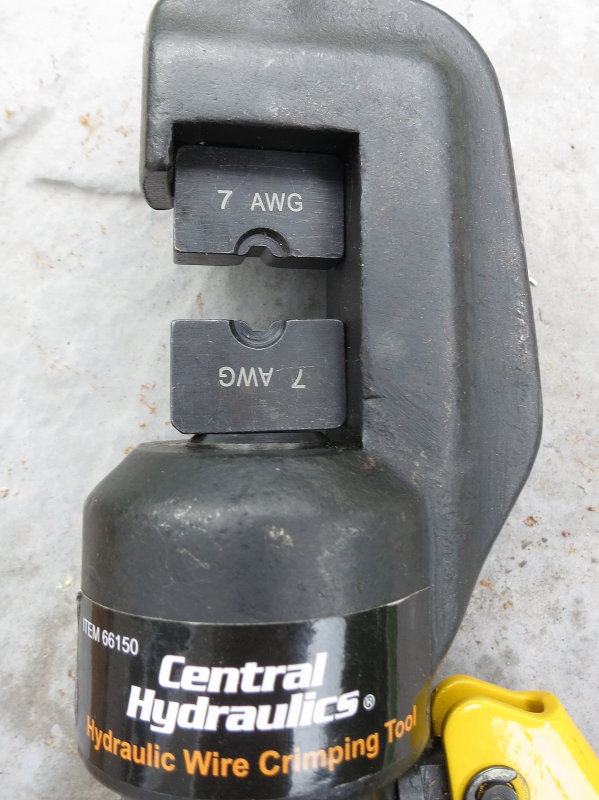
They missed the mark so badly they actually made up a new wire size. (smirk)
Commercially available 7 AWG wire simply does not exist in North America.
These are the standard AWG sizes, that actually do exist, this crimper is claimed to work with…
1/0
1GA
2GA
4GA
6GA
8GA
10GA
12GA
14GA
Why anyone would require a hydraulic crimp tool to crimp 8GA – 14GA wire is beyond me.
Chrome Plated Dies & 7GA Dies?
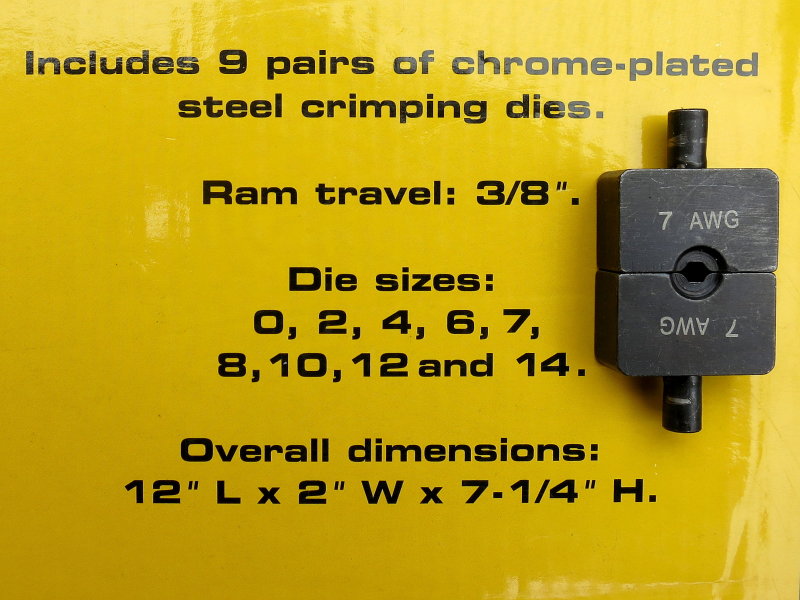
That is some pretty odd chrome plating.? Also interesting to note is that they completely skipped over 1GA wire, which is readily available, but made up 7GA, which is not.. Wow!!!!
Until HFT can get the AWG die size conundrum sorted out I would advise buying a tool from a company that actually knows what they are talking about when it comes to crimping large gauge wire.
While it may not be a horrible tool for sizes smaller than 4GA, this is not a tool for anything larger than 4GA and that simply makes it a very poor value..
If you do decide to buy this tool there should be NO PINCHING when the lugs are crimped. All crimps should look like the 4GA crimp shown.
Expect to burn through about $30.00 – $40.00 in wire and terminals figuring out what dies work with what AWG wire & lugs and when you do WRITE IT DOWN… You’re on your own on figuring this out. I have given you the first one, the 1/0 AWG die works with 4GA starter lugs, but the rest are on your buck.. (wink)
Not Just Harbor Freight That Sells Low Quality Tools

In my multi-year long quest to bring readers a better value than the FTZ crimp tool, I think I have finally given up. Each of the pictured tools (and there have been many, many more) was sold as AWG dies. NONE OF THEM ARE AWG.. Total SCREW JOB… Even when I buy from supposed American companies, that claim AWG tools, they are nothing more than re-stickered Chinese tools.
All three of these tools make HORRENDOUSLY BAD CRIMPS and none of the dies are properly sized for the AWG lugs we use. The tool on the right, I had the most hopes for, as it is an apparent knock off of a $3500.00 US made tool. This knock-off tool is so grossly unbalanced, in your hands, it literally makes it almost unusable. The dies, paint & fit & finish are absolutely HORRIBLE. Not one die in the 10 die set matched any of the AWG lugs I use despite the US “sticker application company” telling me the dies are AWG. I suspect the tech support guy had no clue what AWG even was…?
Bottom line is you can spend a metric $hit ton of money, as I have, experimenting with cheap mysterious die standard tools, or spend the money and just buy the FTZ or TEMCO TH0005 (if you want a hydraulictool).
As far as I am concerned, after buying and testing at least 20+ import battery lug crimping tools, the FTZ is still, hands down, the best value for the money.
IMPORTANT PLEASE READ: We can no longer offer a direct sale of this FTZ crimp tool due to health issues.. Please purchase from our affiliate partner Bay Marine Supply.
Buy FTZ 94284 -BAY MARINE SUPPLY
GOOD LUCK & HAPPY BOATING!

